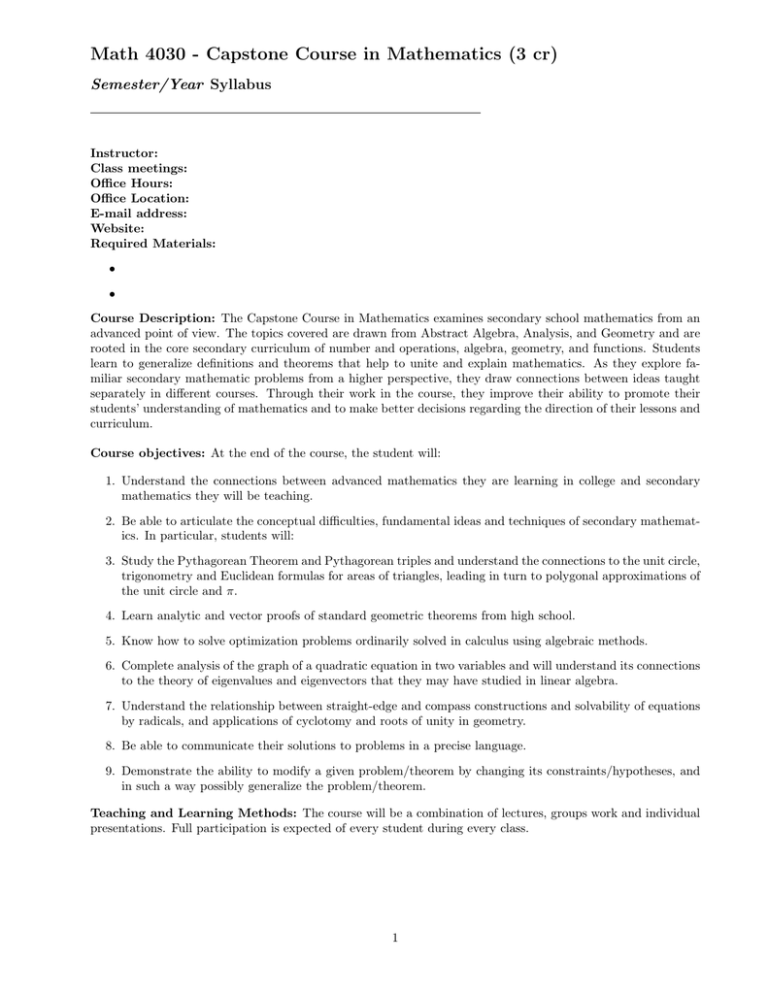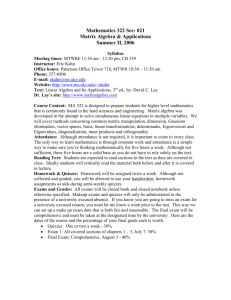Math 4030 - Capstone Course in Mathematics (3 cr) Semester/Year Syllabus
advertisement

Math 4030 - Capstone Course in Mathematics (3 cr) Semester/Year Syllabus Instructor: Class meetings: Office Hours: Office Location: E-mail address: Website: Required Materials: • • Course Description: The Capstone Course in Mathematics examines secondary school mathematics from an advanced point of view. The topics covered are drawn from Abstract Algebra, Analysis, and Geometry and are rooted in the core secondary curriculum of number and operations, algebra, geometry, and functions. Students learn to generalize definitions and theorems that help to unite and explain mathematics. As they explore familiar secondary mathematic problems from a higher perspective, they draw connections between ideas taught separately in different courses. Through their work in the course, they improve their ability to promote their students’ understanding of mathematics and to make better decisions regarding the direction of their lessons and curriculum. Course objectives: At the end of the course, the student will: 1. Understand the connections between advanced mathematics they are learning in college and secondary mathematics they will be teaching. 2. Be able to articulate the conceptual difficulties, fundamental ideas and techniques of secondary mathematics. In particular, students will: 3. Study the Pythagorean Theorem and Pythagorean triples and understand the connections to the unit circle, trigonometry and Euclidean formulas for areas of triangles, leading in turn to polygonal approximations of the unit circle and π. 4. Learn analytic and vector proofs of standard geometric theorems from high school. 5. Know how to solve optimization problems ordinarily solved in calculus using algebraic methods. 6. Complete analysis of the graph of a quadratic equation in two variables and will understand its connections to the theory of eigenvalues and eigenvectors that they may have studied in linear algebra. 7. Understand the relationship between straight-edge and compass constructions and solvability of equations by radicals, and applications of cyclotomy and roots of unity in geometry. 8. Be able to communicate their solutions to problems in a precise language. 9. Demonstrate the ability to modify a given problem/theorem by changing its constraints/hypotheses, and in such a way possibly generalize the problem/theorem. Teaching and Learning Methods: The course will be a combination of lectures, groups work and individual presentations. Full participation is expected of every student during every class. 1 Evaluation Methods and Criteria: • Homework: The homework will be graded for correctness. The grade of each homework set will be based on accuracy, thoughtfulness, completeness and clarity of communication (i.e. there may be no credit given for answers given without work shown). You can use these as study tools for the exams. These homework sets will be due a week or two after assigned. Most likely, I’ll assign homework every week and it will be collected the following week in class. But, this will be discussed and decided more firmly in class as we progress. The lowest homework set score will be dropped, thus late homework sets will NOT be accepted under any circumstances. To turn in the homework, you will need to staple your homework together. Collaborating on homework is allowed, but each student’s homework assignment should be clearly written in his/her own words, leaving no room for interpreting such collaboration with cheating or copying. • Quizzes: I will be giving a quiz every class period. It will vary from week to week, with some quizzes being done as a whole group and other quizzes being completed individually. I will drop the two lowest quiz scores, and as such, there will not be any way to make up a quiz or take it at a different time than in class. • Grading: Quizzes: Homeworks: Final exam: 25 % 45 % 30 % • Grading Scale: Although I’m not philosophically opposed to curving grades, I find it’s rarely necessary. The grade scale will be the usual: A (93-100), A- (90-92), B+ (87-89), B (83-86), B- (80-82), C+ (77-79), C (73-76), C- (70-72), D+ (67-69), D (63-66), D- (60-62), E (0-59). If I do need to curve the grades, I will simply shift everything down by a few points (whatever is necessary). Schedule of Topics and Due Dates: Accommodations: The University of Utah seeks to provide equal access to its programs, services and activities for people with disabilities. If you will need accommodations in the class, reasonable prior notice needs to be given to the Center for Disability Services, 162 Olpin Union Building, 581-5020 (V/TDD). CDS will work with you and the instructor to make arrangements for accommodations. All information in this course can be made available in alternative format with prior notification to the Center for Disability Services. Faculty and Student Responsibilities: 1. In an effort to create a vibrant learning community, cell phones and other electronic devices will not be allowed in class. 2. You will be allowed a scientific calculator on all exams. A graphing calculator will not be allowed on exams. In class, you are welcome to work on a graphing calculator. You may not use a cell phone calculator. 3. The syllabus is not a legally binding contract. The instructor reserves the right to change any portion of the syllabus provided you are given enough notice. 2




